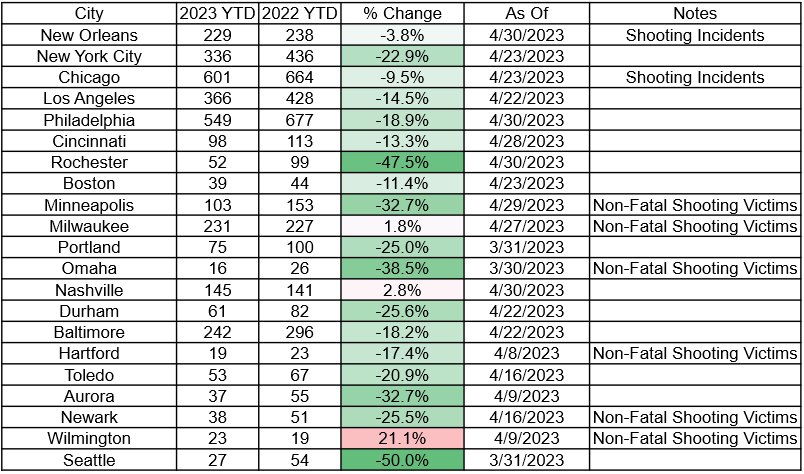April Update - Gun Violence Is Still Falling Nationally
Checking our data sources to take the pulse of shootings in America
In a sane world there would be a way to easily measure national crime trends in near real time, but that is not the case in the United States right now. Luckily there are other data sources that we can use to identify trends in gun violence, namely publicly available data from big cities and the Gun Violence Archive. These data sources all point to steadily falling gun violence nationally through the first 1/3 of 2023.
Of course, it is still early in the year for using YTD counts at a city level, but the totality of available evidence points to a larger trend of falling gun violence is continuing nationwide. To see the bigger trend, I was able to pull YTD shooting counts for 21 cities that had such data publicly available through at least the end of March. Shootings are down in 18 of those cities with a double-digit percent decline in 17 of the 21 cities.

Looking bigger, our YTD murder tracker has YTD data from 74 cities so far in 2023. Murder — not just via firearm — is down about 10 percent so far in that sample of cities comparing this year to the same timeframe last year. Murder is up in 26 of the 74 cities (35 percent), it is even in 9 cities (12 percent), and it is down in 39 cities (53 percent). Some of these cities only have one or two months of data, but the decline doesn’t change much when restricted to just the 52 cities with data through at least the end of March (-9.5 percent).
Big cities tend to overstate the national trend which also appears to be the case this year based on GVA data showing a smaller decline nationwide compared to data from big cities. I collected data from GVA on the last day of the month for every month since 2018 using the Wayback Machine to create a rolling estimate of gun violence nationally.
The number of people that were shot nationwide in the first four months of 2023 was down roughly 3.6 percent relative to the first four months of 2022 (roughly1 16,857 vs 17,488) though there were 23.8 percent more people shot in the first four months of 2023 compared to the first four months of 2020.

It is still too soon to guesstimate what all this means for the year end change in murder and gun violence. Data through April in each of the last three years was not particularly predictive of the year end change. It is worth continuing to follow though as a sizable decline in murder and shootings (relative to 2020-2022) seems like the most likely outcome four months into 2023.
I have found that GVA is accurate albeit imprecise when measured at a city level. The overall trend should be very accurate even if the exact number of shooting victims may not be a precise official count.



